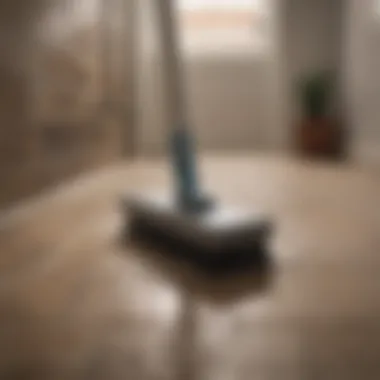Effective Techniques for Removing Mold from Shower Grout


Intro
Mold in shower grout is a prevalent issue many homeowners face. It develops in damp, warm environments and can lead to unsightly stains, unpleasant odors, and potential health issues. Recognizing the importance of addressing mold, this article explores effective techniques to remove it. We will highlight practical cleaning solutions, suggest helpful tools, and provide preventive measures to maintain a mold-free environment.
Understanding mold growth is essential to combatting it effectively. Mold requires moisture, warmth, and organic materials to thrive. Grout, which often contains silica and can absorb water, provides an ideal substrate. When left unchecked, it can lead to more serious damage that may compromise the integrity of tiles and other surfaces.
This guide aims to equip homeowners with valuable knowledge on how to tackle mold in shower grout systematically. By employing the right methods and maintaining vigilance, you can enhance both the aesthetic and longevity of your bathroom surfaces. The insights presented will not only aid in the removal process but also empower you to implement effective strategies for long-term success.
Understanding Mold Growth in Showers
Mold growth in showers is a common concern for many homeowners. It's essential to understand how mold develops, particularly in shower grout, as it not only compromises aesthetics but also poses several health risks. Mold often thrives in damp, warm environments, making bathrooms, especially showers, prime locations for its growth. This section aims to clarify why it is crucial to understand mold growth mechanisms in showers.
By being aware of common causes of mold, homeowners can take proactive steps to mitigate risk factors. Such knowledge enables individuals to create strategies for prevention and long-term maintenance.
Furthermore, gaining an understanding of mold types and their growth environment can help in choosing the most effective cleaning techniques. This knowledge is a fundamental aspect of ensuring a healthier living space and maintaining the integrity of bathroom surfaces.
Common Causes of Mold in Shower Grout
Several factors contribute to mold growth in shower grout. Key causes include:
- High humidity levels: Bathrooms typically have air that is more humid due to showers and baths. This moisture creates an ideal breeding ground for mold spores.
- Poor ventilation: Lack of proper airflow can trap moisture in the shower area. Good air circulation is crucial to help keep surfaces dry.
- Water leaks: Drips from faucets or showerheads can add excess moisture, allowing mold to thrive. Regular checks for leaks are important.
- Dirt and soap residue: Accumulated grime attracts mold spores. It is important to regularly scrub the grout lines to remove these potential food sources.
Understanding these causes helps homeowners to make informed choices about cleaning and prevention methods. Taking action early can save significant effort and time in the long run.
Health Risks Associated with Mold Exposure
Exposure to mold can lead to several health issues, affecting individuals differently based on their sensitivities. Key health risks include:
- Respiratory Issues: Mold spores can irritate the respiratory tract and cause conditions like asthma or allergic reactions, especially in sensitive individuals.
- Skin Irritation: Contact with mold can lead to rashes or other skin problems.
- Neurological Effects: Some studies suggest that prolonged exposure to certain molds can affect brain health and cognitive functions.
- Infections: For those with weakened immune systems, mold can lead to serious infections.
Mold exposure may be particularly dangerous for infants, the elderly, and individuals with pre-existing health conditions.
Recognizing the health risks associated with mold in shower grout underlines the importance of regular cleaning and preventive measures. Protecting yourself and your family from these health hazards is a crucial reason for ongoing attention to mold management.
Identifying Mold Types in Shower Settings
Identifying the types of mold present in shower settings is a crucial step in the overall process of mold removal and prevention. Different types of mold may respond differently to cleaning agents. Additionally, knowing specific characteristics can aid in efficiently targeting the appropriate removal method. Understanding the mold types helps homeowners recognize potential health risks and informs them about how to act if they encounter a problem.
Types of Mold Found in Bathrooms
Mold found in bathroom environments can be diverse, but some common types include:
- Aspergillus: This type appears in various colors and is often found in damp areas. It can produce allergens and toxins that may pose health risks.
- Penicillium: Typically blue or green, Penicillium thrives in moist environments. Aside from being unsightly, it can trigger allergic reactions in sensitive individuals.
- Stachybotrys: Known as black mold, Stachybotrys is often associated with severe health issues. It usually grows in places with persistent moisture, making identification imperative for safety.
- Cladosporium: This mold type is commonly found outdoors, but can also invade bathrooms. It presents a green or black appearance and can lead to respiratory issues.
Understanding these types allows homeowners to better assess the situation and take targeted action.
Visual Indicators of Mold in Grout
Identifying mold visually in shower grout is often straightforward. Homeowners should look for specific signs:
- Discoloration: Mold often causes dark or discolored patches within the grout. This is usually the first visible sign of a larger problem.
- Fuzzy or Slimy Texture: Many molds have a fuzzy appearance. If you notice any areas that feel slimy when touched, this could indicate a mold infestation.
- Musty Odors: A persistent musty smell usually suggests mold growth, even if it is not yet visible. This indicates that moisture is consistently present, which is inviting for mold.
- Cracks or Peeling Grout: If the grout shows signs of damage or deterioration, it may be a breeding ground for mold spores. It’s wise to address these issues promptly.


Identifying mold types and their visual indicators is a critical component in properly addressing mold issues in showers.
By remaining vigilant and aware of these factors, homeowners can effectively combat mold growth and create a safer, healthier living environment.
Essential Tools and Supplies for Mold Removal
Effective mold removal from shower grout requires a carefully selected array of tools and supplies. These tools not only facilitate the cleaning process but also ensure safety for the user. Understanding what is essential in this regard will help any homeowner or design enthusiast to tackle mold issues confidently and effectively.
Basic Cleaning Tools Required
When preparing to remove mold from shower grout, having the right basic cleaning tools is crucial. A proper kit usually consists of:
- Scrub Brush: A stiff-bristled scrub brush is essential for dislodging stubborn mold from the grout lines. A smaller brush can sometimes reach in tighter spaces.
- Protective Gear: Gloves, goggles, and a mask are necessary to protect against mold exposure and cleaning chemicals.
- Sponge or Cloth: Soft sponges or cloths should be part of your kit. They are useful for applying cleaning solutions without damaging the grout.
- Bucket: A bucket holds water and cleaning solutions, making the cleaning process organized.
- Old Toothbrush or Similar Tool: For detailed cleaning, an old toothbrush works effectively for targeting specific spots.
These tools form the foundation of your mold removal efforts. They allow for a thorough approach and aim for a cleaner, healthier shower environment.
Recommended Cleaning Solutions
Once the tools are at hand, selecting the appropriate cleaning solutions becomes important. The type of mold present can influence this choice, but some popular and effective options include:
- Bleach: A solution of one part bleach to ten parts water can treat mold effectively. It kills spores and whitens grout. However, use it cautiously as it can irritate skin and lungs.
- Vinegar: Distilled white vinegar offers a natural alternative. It can help dissolve mineral deposits and inhibit mold growth. It is eco-friendly and safe for most surfaces.
- Baking Soda: This common household item can be mixed with vinegar to create a paste. Applying it on mold can help to lift it off surfaces.
- Store-bought Mold Cleaners: Certain products are specially formulated for mold treatment. Brands like R MR- Clean and Zep provide options that can simplify the process and reduce effort.
Choosing the correct cleaning solution is vital. It can influence the effectiveness and safety of mold removal efforts. Homeowners should take the time to read the instructions on the products carefully.
"Effective tools combined with the right cleaning solutions create a powerful duo against stubborn mold."
In summary, having the right tools and cleaning solutions significantly contributes to successful mold removal from shower grout. Taking the time to prepare can lead to better results and a mold-free environment.
Step-by-Step Cleaning Process
Removing mold from shower grout requires a systematic approach. This process is crucial because it helps ensure that all steps are taken effectively to eliminate mold and prevent its recurrence. By following a step-by-step method, you reduce the risk of overlooking a crucial element in the cleaning process. Additionally, it streamlines the entire procedure, making it more efficient and effective.
Preparation and Safety Measures
Before diving into the actual cleaning, preparation is key. Take the time to gather all necessary tools and supplies. Ensure that you have adequate ventilation in the area by opening windows or turning on exhaust fans. Good air circulation helps to minimize exposure to fumes from cleaning solutions, which could be harmful.
- Wear Protective Gear: Use gloves, goggles, and a mask. This gear protects against mold spores and chemical exposure.
- Clear the Area: Remove any items from the shower that might get in the way. This includes towels, shampoos, and any decorative items.
- Test for Sensitivities: If you have allergies or respiratory conditions, consult with a professional before using certain cleaning solutions.
Taking these precautionary steps ensures a safe cleaning environment and increases the likelihood of a successful mold removal effort.
Application of Cleaning Solutions
Once you have prepared the area, the next step is to apply the appropriate cleaning solutions to the affected grout. Different solutions have varying levels of effectiveness against mold.
- Choose the Right Solution: Some popular options are vinegar, baking soda, or commercial mold removers. Each of these works differently:
- Follow Instructions: Apply the cleaning solution according to the manufacturer’s instructions. This may involve spraying, scrubbing, or letting it sit for a period.
- Target the Grout Lines: Focus on the grout lines where mold tends to accumulate. Ensure the cleaning solution is directly on the mold.
- Vinegar: A natural option that can penetrate mold and remove it effectively.
- Bleach: Strong for killing mold but may not be suitable for all grout types.
- Commercial cleaners: Often designed specifically for mold removal and may offer faster results.
By applying the right amount and type of cleaning solution, you maximize your chances of successful mold removal.
Scrubbing Techniques for Effective Removal


After the cleaning solution has set, the next step is scrubbing. This action is vital for physically removing the mold and any residual discoloration.
- Use the Right Tools: A stiff-bristled brush or an old toothbrush can be effective. Ensure the tool is clean to avoid introducing more mold spores.
- Scrub Methodically: Focus on small sections at a time. Apply firm pressure and scrub in a circular motion to lift the mold from the grout.
- Rinse Thoroughly: After scrubbing, rinse the area with warm water to wash away any leftover cleaning solution and dislodged mold.
Tip: For particularly stubborn patches, you may need to repeat the scrubbing process.
With proper scrubbing techniques, you can restore the appearance of your shower grout and reduce the likelihood of mold returning.
"Regular maintenance will help keep your grout mold-free, reducing the need for intensive cleaning sessions in the future."
This step-by-step approach ensures not just the removal of mold but also lays the groundwork for a cleaner, healthier bathroom environment.
Dealing with Stubborn Mold Issues
Mold can be a persistent problem, especially in areas with high moisture like shower grout. Recognizing how to address these issues is vital for maintaining a clean and healthy bathroom environment. This section will focus on important strategies for dealing with mold that refuses to go away. Addressing stubborn mold effectively can help preserve the integrity of the grout and prevent further damage to the surrounding tiles.
When to Consider Professional Help
Sometimes, despite your best efforts, mold might persist. Delaying action can lead to further growth and more severe cleaning challenges. Here are some indicators that it might be time to call in a professional:
- Widespread Mold Damage: If you notice widespread mold growth beyond just a few tiles, professional help may be necessary. High mold levels can indicate hidden water damage beneath surfaces.
- Health Concerns: If you or your family experience health issues like allergies or respiratory problems that seem to be linked to mold exposure, professionals can ensure it is safely removed.
- Persistent Odors: A musty smell that remains after cleaning efforts is a sign that mold may be lurking out of sight.
- Inaccessible Areas: Areas that are difficult to reach, like behind tiles or in grout lines, often hold hidden mold. Professionals have tools designed for these tough spots.
Hiring professionals does not only ensure the mold is effectively removed but can also reduce the risk of damage to your bathroom surfaces. The monetary cost may seem high, but it can save you more in the long run by preventing further damage and maintaining the value of your home.
Long-term Solutions for Persistent Mold Problems
To combat future mold issues, implementing long-term strategies is essential. Consider the following solutions to keep mold at bay:
- Upgrade Ventilation: Ensure your bathroom is well-ventilated. Installing exhaust fans can significantly improve air circulation. Aim to keep moisture levels low, especially after showers.
- Use Mold-Resistant Products: When renovating or maintaining your bathroom, consider using mold-resistant grout or paint. These products are formulated to inhibit mold growth.
- Regular Cleaning Schedule: Establish a regular cleaning routine. Frequent inspections and prompt action against any beginnings of mold go a long way in preventing serious infestations.
- Seal Grout Lines: A sealant can protect grout from moisture. Reapplying the sealant every few years can help maintain a barrier against mold.
- Monitor Humidity Levels: Use a hygrometer to keep an eye on humidity. Ideally, indoor humidity should be kept between 30% and 50%.
Using these strategies will create an environment less conducive for mold growth, enhancing the cleanliness and aesthetics of your shower.
"Preventing mold is often easier than removing it."
By addressing mold proactively, you can enjoy a healthier and more pleasing shower environment.
Preventative Measures to Avoid Mold Recurrence
To effectively combat mold growth in shower grout, it is essential to implement preventative measures. Preventing mold not only enhances the aesthetics of your bathroom but also safeguards health and prolongs the lifespan of your tiles and grout. Taking these steps seriously will minimize the recurrence of mold and help maintain a clean and inviting shower space.
Importance of Proper Ventilation
Proper ventilation plays a crucial role in mold prevention. When showers are used, steam and moisture accumulate in the air. This damp environment provides an ideal breeding ground for mold spores. Ensuring good airflow helps to reduce humidity levels, allowing the surfaces to dry more quickly after shower use.
Consider these points regarding ventilation:
- Exhaust Fans: Installing a quality exhaust fan in the bathroom can significantly help. Turn it on during and after your shower to expel moist air. Ideally, it should run for at least 20 minutes post-shower.
- Windows: Open windows to promote air exchange. Even a small opening can facilitate airflow, helping to reduce humidity levels.
- Door Gaps: Keep bathroom doors ajar after use. This encourages better airflow and helps the moisture escape more easily.
Incorporating these ventilation strategies will create a less hospitable environment for mold.
Routine Maintenance Tips for Mold Prevention


Regular maintenance can drastically reduce the chances of mold returning. Adopting a consistent cleaning routine helps to keep the shower areas in check. Here are some simple practices that can be highly effective:
- Daily Squeegee Use: Encourage the habit of using a squeegee on shower walls and doors after each use. Removing excess water minimizes moisture build-up.
- Weekly Cleaning: Schedule a weekly cleaning of the shower area. Use a mold prevention solution or a light bleach mixture. This will keep mold spores at bay even in small amounts.
- Fix Leaks Promptly: Any leaks from pipes or grout should be addressed quickly. Water dripping from fixtures can lead to increased moisture levels.
- Inspect Grout Regularly: Check grout lines regularly for cracks or damage. Prompt repair can prevent water infiltration and mold growth in hidden places.
"An ounce of prevention is worth a pound of cure."
Addressing these small tasks consistently reinforces a healthy and mold-free environment. This will save you time and effort in the long run, keeping your shower grout looking clean and fresh.
Alternative Methods for Mold Removal
Alternative methods for mold removal are crucial for homeowners seeking effective solutions that align with their preferences or sensitivities. These methods often provide a more environmentally-friendly approach compared to traditional chemical cleaners. In addition, they may be more accessible and less expensive, which is appealing to those looking to maintain their budgets while ensuring a clean living space.
Among the benefits of using alternative methods are the reduced risk of harsh chemical exposure and the potential for using ingredients commonly found in households. These methods can often be just as effective in mitigating mold growth, as long as they are approached with care and preparation. It is essential, however, to understand their limitations and application techniques to achieve desirable results.
Natural Cleaning Solutions
Natural cleaning solutions can be an excellent first line of defense in the battle against mold in shower grout. Ingredients like white vinegar, baking soda, and hydrogen peroxide are popular due to their mold-killing properties and ease of use.
White Vinegar: This pantry staple has antifungal and antibacterial properties. To use it, apply undiluted white vinegar directly to the moldy area and let it sit for at least an hour. After that, scrub it with a brush and rinse thoroughly with water.
Baking Soda: This not only neutralizes odors but also helps remove stains. It can be applied by mixing baking soda with water to create a paste. Applying the paste to the moldy grout and scrubbing it can yield effective results. Rinse well after scrubbing.
Hydrogen Peroxide: Known for its bleaching capabilities, hydrogen peroxide can be used on grout. Apply a 3% solution directly on the grout, let it sit for ten minutes, then scrub and rinse.
These solutions are not just effective; they are safe for most surfaces, making them suitable for regular maintenance as well.
DIY Techniques for Grout Cleaning
For homeowners looking for hands-on techniques, DIY methods can provide effective solutions for grout cleaning. These methods can save money while ensuring a thorough cleaning process.
- Scrubbing with a Toothbrush: Paying attention to detail, use an old toothbrush to reach into the grooves of the grout. This can help remove mold without damaging the tiles. Make sure to apply your chosen cleaner effectively using the brush to scrub those tight spots.
- Steam Cleaning: If you have a steam cleaner, it can be an effective and chemical-free way to remove mold. The high temperature of the steam kills the mold spores, making it easier to wipe away. Just ensure that the tiles and grout can handle the heat.
- Essential Oils: Some essential oils like tea tree oil or lavender oil have natural antifungal properties. Mix a few drops into your cleaning solution for added effectiveness and a pleasant scent.
“Choosing natural and DIY approaches can lead to long-term benefits in maintaining cleanliness while reducing exposure to chemicals.”
These methods emphasize a combination of accessibility and effectiveness. By employing easy-to-make solutions and simple techniques, homeowners can achieve a clean, mold-free shower grout without over-reliance on harsh chemicals.
Closure and Final Thoughts
Addressing mold in shower grout is critical for maintaining both the aesthetic appeal and the safety of your bathroom environment. Mold can multiply quickly, leading to unsightly stains and potential health risks. This article outlined effective techniques in removing such mold, providing step-by-step guidance to homeowners looking to take proactive measures against this issue.
Key elements discussed include identifying mold types, understanding the necessary tools, and employing both natural and commercial cleaning solutions. It is far more efficient to integrate these techniques into a regular cleaning regimen, rather than waiting for mold to establish itself. This preventative approach not only saves time but also ensures healthier living spaces.
By following the practical advice offered, homeowners can successfully combat mold growth. The benefits extend beyond immediate appearance; long-term maintenance practices can significantly prolong the life of shower grout while promoting a healthier atmosphere. Mold problems need not become a recurring nightmare; with diligence and the right techniques, it is possible to create and maintain a mold-free shower environment.
Summarizing Key Points
- Understanding Mold Growth: Mold thrives in moist environments, making showers particularly vulnerable. Awareness of common causes helps in preventing its formation.
- Tools and Solutions: Essential tools like scrub brushes and effective solutions, such as vinegar or bleach options, are crucial for effective cleaning.
- Step-by-Step Process: A systematic approach to the cleaning that includes preparation, application, and scrubbing techniques yields the best results.
- Long-term Solutions and Prevention: Choosing ventilation and routine checks go a long way in keeping shower grout free of mold.
Encouragement for Ongoing Cleaning Practices
Consistent maintenance is the cornerstone of keeping mold at bay. Establishing a cleaning routine can greatly diminish the likelihood of mold resurfacing. Homeowners should consider cleaning grout at least once a month, focusing on areas that attract moisture.
Regular Practices to Implement
- Use a squeegee after every shower to remove excess water.
- Consider placing a dehumidifier in the bathroom for persistent moisture issues.
- Opt for cleaning solutions that contain mold inhibitors, as a part of regular cleaning products can be highly effective.
Ultimately, the responsibility lies with each homeowner to create a welcoming and healthy living space. By applying the techniques discussed throughout this article, you should feel empowered to tackle mold head-on. With continuous effort and a strategic mindset, achieving and maintaining a pristine bathroom environment is an attainable goal.



